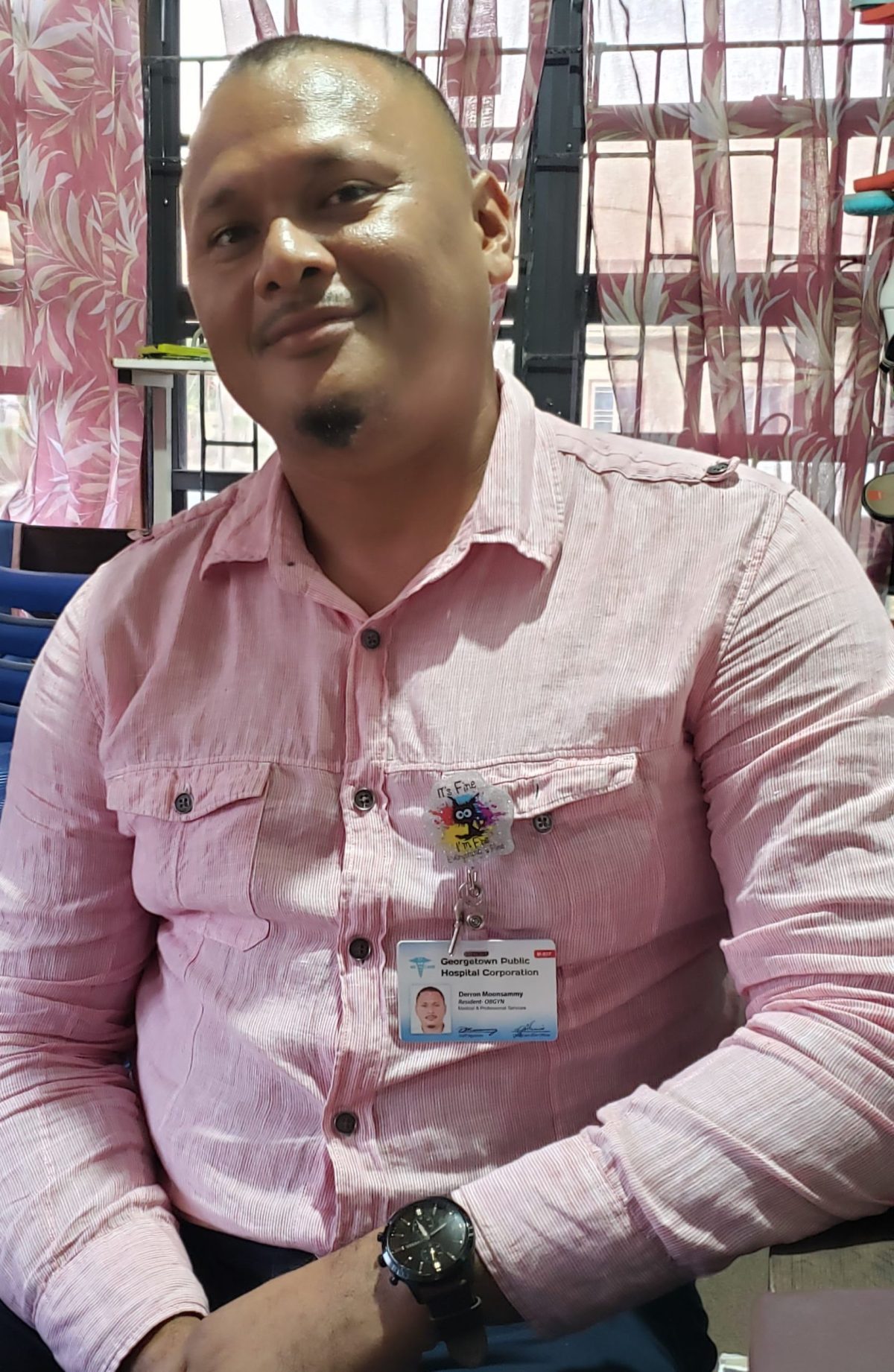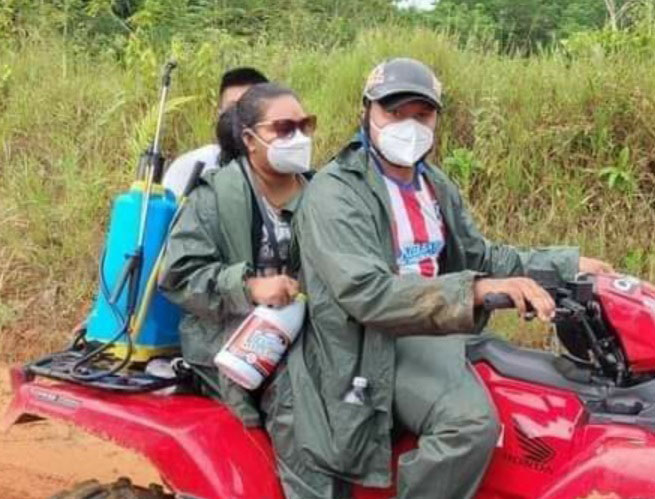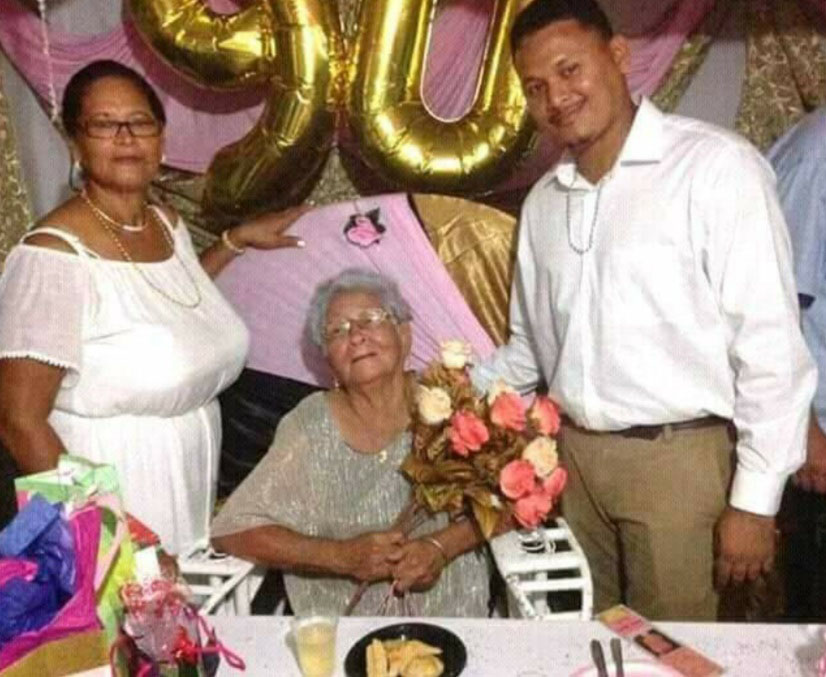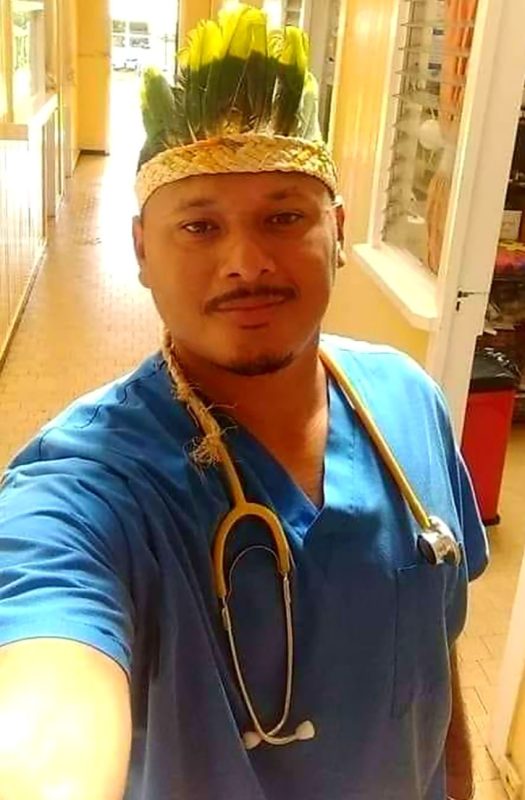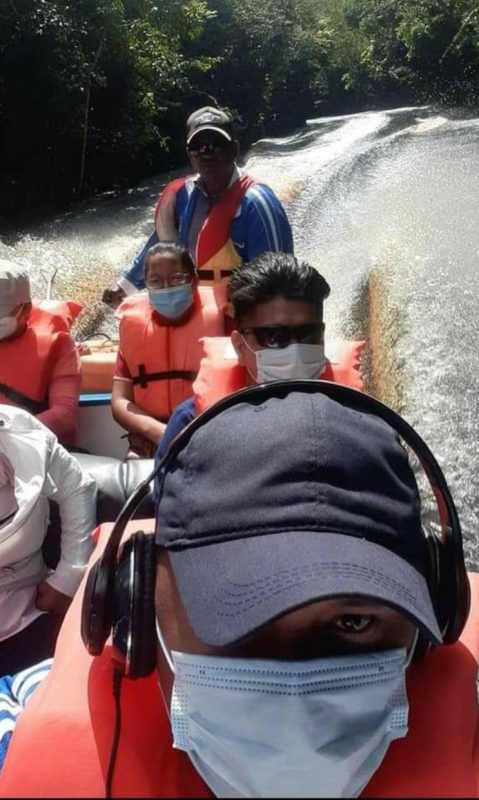Medical practitioner Derron Moonsammy of Mabaruma Township in Region One, who joined the profession on the insistence of his mother, is now in his third year, specialising in the Ministry of Health’s obstetrics/gynaecology program-me.
“In this profession, each patient is like a treasure. I believe in Jesus. There were times I wanted to give up, but something always happens to restore my faith and hope which have been magnified in this work,” he told Stabroek Weekend.
Shortly after starting the obstetrics and gynaecology programme, Dr Moonsammy said, he felt like quitting. He was on call in the accident and emergency department, had his studies to cope with and was feeling depressed when a woman approached him crying. She told him she was about 13 weeks pregnant; her first pregnancy.
“… The baby was surrounded by large fibroids. She looked like she was almost about to give birth instead of being 13 weeks. Every specialist she went to, told her the baby won’t make it. The fibroids would eventually rupture the water bag, the baby will be premature, chances of survival, very slim and even if the baby was born it would have some deformities because of the fibroids pressing on the placenta,” he related.
He said she wanted to keep the baby but because of the specialists’ advice she felt she had no choice. He said, “I don’t know what came into me, but I told her, ‘God has got you and he is going to make a way. Don’t abort the foetus’.”
He monitored her pregnancy and at one stage, he said, the ultrasound showed that most of the fibroids had died around the placenta and the baby’s head had turned to deliver.
“I was shocked at what I saw. The baby was normal on the ultrasound. She went to almost nine months and the water bag did rupture but the baby, a boy, was full term and so we did a caesarean section,” he said.
Because the fibroids started to bleed the doctors performed a hysterectomy. She recovered and asked Dr Moonsammy to be her child’s godfather.
“I felt blessed,” he said. “I told myself it was God’s will that I was there at that moment in time to tell her to keep the baby. That was a pivotal moment for me. I said maybe all that I am going through is just a learning experience. God will allow me to go where he wants me to go.”
He said that he did not choose medicine, medicine chose him.
“I didn’t choose obs and gynae too. I think they chose me because of the high maternal mortality in Region One. At one time we had one of the highest mortality rates in the country. It was a big stain on the region,” he said.
When he worked at Kumaka District Hospital, he said, many times pregnant women preferred to take the chance and deliver there rather than be referred to Suddie Public Hospital because they claimed they were not treated well there.
Should he work at Kumaka District Hospital as a specialist, he said, he could stop the referrals to Suddie as most women prefer to deliver in familiar surroundings.
“That would help to reduce maternal mortality. This was what also motivated me to work in obstetrics and gynaecology. I’m keeping my fingers crossed, hope all goes well and I successfully complete the programme in another year and a half. Once I am qualified, I hope I can go back to Mabaruma or Kaituma or Moruca to serve. I like the hinterland more than the coastland. Georgetown is nice but it’s noisy, cramped, polluted and expensive,” he said.
Born in Georgetown, Dr Moonsammy grew up in Mabaruma where he had his nursery, primary education and junior secondary education. After a successful sitting of the Caribbean Secondary Education Certificate (CSEC) examina-tions at North West Secondary School, he spent a year in Lower Sixth Form at the Bishops’ High School after which he took night classes and wrote several science subjects at the Caribbean Advanced Proficiency Examinations (CAPE) at the Business School on Brickdam. He then returned to Mabaruma and began teaching Integrated Science, Mathematics and Visual Arts at his alma mater.
During this period, his mother Marilyn ‘Pinky’ Smith who worked at Region One regional administrative office saw an advertisement for Cuban scholarships in different fields of study.
She asked him to apply but he was not keen. When he was 16 years old, he had applied to do the veterinary programme with his CSEC subjects but was not sufficiently qualified.
He recalled, “She was behind me for a week to apply. She said, ‘What do you have to lose?’ Apply, Apply, was her mantra. This time I had science subjects at CAPE. There were different programmes, veterinary, medicine, agronomy. I was teaching the science subjects and I always liked the sciences anyway, so eventually, I applied to do medicine and the rest is history.”
Growing up Dr Moonsammy wanted to be many things, including a footballer, a cricketer but becoming a medical doctor was not one of them.
“I never thought I’d become a medical doctor until I started studying medicine,” he noted.
However, he did play football for Plaisance Panthers Football Club and he played for the East Coast Demerara under-19 team before he left Guyana for Cuba in 2007. He also played volleyball and basketball.
Cuba
Before leaving Guyana, he was confident he could converse in Spanish. But when he joined a Copa Airlines flight from Trinidad and Tobago to Cuba and the air hostess started speaking in Spanish, he said, he realised, “I didn’t know Spanish. I had to live with a Spanish/English dictionary for a while after that. We had to do every subject in Spanish. In the classroom there was no English. Our teachers who taught us knew no English. However, they were the best.”
Dr Moonsammy went to Cuba in what was the largest batch of Guyanese medical students, some 310.
For the first three years, students were taught at a school in Sandino, Pinar del Rio which was surrounded by an orange grove in a rural area with the nearest community shop and discotheque about five miles away. The mode of transportation to get there was the horse cart.
“There were about 20-something schools around with each having on roll about 300 students and there was just this one shop and one discotheque,” he recalled.
For the fourth, fifth and sixth years they were placed in a facility in Havana with students from 36 other countries.
“There were about 2,000 medical students and 14 of us shared a room.
It was challenging to wake up early to join a line to bathe in one or two bathrooms that were available for about 125 students. There was no privacy,” he said.
After two months, he rented a room from an elderly Cuban woman. “I paid the equivalent of $3,000 a month. That was about a lot of money for her. She treated me like a mother. Most of us rented from people who had our complexion so when the police came, we were passed off as family,” he said.
Once his accommodation was sorted out, he said, studying and coping with transportation woes were no longer problems.
After Cuba he did his internship at New Amsterdam Public Hospital from 2013 where he was for 18 months. On obtaining his institutional licence he returned to his hometown in Region One in 2015.
Region One
Back in Mabaruma, Dr Moonsammy was treated with respect.
“People called me ‘doctor’ and some of my past students called me ‘Sir’. Sometimes I was the only doctor running the hospital, which was something because I had to learn to make decisions involving life and death,” he said
In 2016 he was assigned to Port Kaituma District Hospital as the doctor in charge.
The most challenging place he had to access as part of a medical outreach and vaccination programme was the mining area of Five Star in the Matarkai (Matthew’s Ridge/Arakaka/Kaituma) District. Port Kaituma Hospital oversees Pakera Hospital at Matthew’s Ridge and is responsible for the communities at Five Star, Canal Bank and Sebai.
“We hired a pick-up truck that had no lights,” he recalled. “It was a six-hour drive via Fall Stop, Arakaka and branching off from the road to Matthew’s Ridge to a landing to get to Five Star. The radiator kept on heating up and we had to throw water in it to cool it down. When we got to Five Star Junction, in the middle of the forest with nightfall rapidly approaching, the vehicle got stuck in the muddy slushy road. I was in the uncovered tray of the vehicle while the two female nurses were in the cabin with the driver. There I was contemplating how we were going to spend the night, me being in the open. Then a big green truck came by and pulled us out and it got stuck. We couldn’t help them, so we left. With no vehicular lights we used our cell phones for the driver to see where we were going.”
From the landing to Five Star they travelled by a dugout boat the next day for about eight hours and pulled the boat over three rapids.
“When we got to Five Star everyone was in the backdam. We had to go in the backdam with an ATV driving on barrancas. It took us two hours to get to the camp. We spent two days at Five Star. There were a lot of communities around Five Star and after messages were sent out that we were there, we had to wait for the people to come to us,” he related.
Returning to Port Kitum was less daunting as some people returned with them and helped them.
“These are some of the challenges that health workers face. My most challenging experiences were in outreaches with pregnant women and injuries from accidents and having to move them for adequate treatment,” he said.
Next, Dr Moonsammy was sent to Kumaka District Hospital in Moruca where, after a short period, he became the doctor-in-charge.
In Moruca he did a lot of outreaches. Geographically, it is bigger than Matarkai and Mabaruma with more communities.
“Each place had its own peculiarities. Travelling to certain riverain areas was easy when the water was high. Most times we travelled by outboard boats and engines or ATVs. Sometimes we went in canoes to some areas where outboard engines couldn’t go,” he said.
Kunaka District Hospital was also responsible for 14 health posts, and two health centres.
“At one time I was the only doctor for about seven months. As we got more doctors, I was free to do more outreaches,” he said.
Dr Moonsammy spent six years in Region One.
Covid-19
He was the doctor in charge of Kumaka District Hospital when Covid-19 struck.
“We tried our best to keep Covid-19 out of the community using lockdown and monitoring methods. After our first case we started to get a lot more. Most of the patients were asymptomatic. That was why we started testing everyone and that was why it looked like we had so many cases. Other places didn’t carry out the number of tests like we did,” he related.
It was difficult finding places to isolate patients, he said. They used two main venues, the Acquero Guest House, and the Amerindian Hostel at Kumaka and subsequently the Santa Rosa Secondary School dorms.
The doctor and medex who looked at the first case tested positive and were isolated. That left Dr Moonsammy and three nurses to look after patients.
Following the safety protocols every time they visited patients in isolation they had to bathe and change their clothing.
“We were trying our best not to get infected. At some point in time, I got infected. I was very careful in the hospital. I was placed with the patients at the Amerindian Hostel at Kumaka where we were isolated for 36 days initially,” he said.
At the time there were no vaccines and Dr Moonsammy, who thinks he was infected through socialisation, said that following the first two days after testing positive he was not scared.
“I had one day of symptoms. I had pain in my hands, and I felt very fatigued. I didn’t have the cough or the loss of smell or taste, or shortness of breath,” he said.
Dr Moonsammy did not see the first Covid-19 patient. However, when he saw that the patient’s blood sample was dark in colour, which to him was an indication of a lack of oxygen, he told the staff to wear their PPEs. The medex and the other doctor who had contact with the first casualty subsequently tested positive along with another person who handled the patient.
“I was the only doctor left to see patients. Shortly after Dr Arielle Savory and Dr Sarah Benjamin who hail from Moruca and Dr Hendricks of St Cuthbert’s Mission along with the late Chief Medex Lolita Rebeiro, voluntarily came in to relieve us,” he said.
In 2021, he was reassigned to the Georgetown Public Hospital.
Writing
While in isolation, Dr Moonsammy, who loves to write short stories and poems, wrote a book, “Forgotten Origins” about Amerindian traditions. It is based on an Indigenous group of people transforming themselves into the mystical ‘kanaima’. The book tells of Amerindian traditions, Guyana’s tourism products, and Guyana being a haven for foreign investors.
The story is about a foreign investor coming to Guyana with his wife, a lover of birds, who was suffering from cancer. The investor flew from Georgetown to Warapoka to see the harpy eagle and there learned how and why his wife was suffering from cancer through the work of the piaiman (shaman).
The man gets to see how the kanaima rescues an abducted child, his wife is cured of cancer and he became a kanaima himself.
“You have to read the book about how the kanaima became a kanaima,” Dr Moonsammy said.
Apart from writing and telling stories, the father of two and husband, is also artistic and likes painting, sculpting, making wooden craft and furniture some of which is found in his home.
Dr Moonsammy’s background is rooted in the Warrau people. His maternal grandmother, Naomi Smith, is from Waramuri while his paternal grandfather is Warrau and Arawak. However, both his paternal and maternal grandparents are also of African, East Indian and European ancestry.
“My maternal grandmother, now 97, is fluent in the Warrau language and knows a lot of the customs. She grew up in the traditional Warrau setting. As a child my mother didn’t want me to learn about that traditional side. She didn’t think it was something useful. When I look back at things, I really should have learnt the language from her. We have many Warrau patients who do not speak English. If I had known the language, I would’ve been able to communicate with them,” he said.
Since he became aware of the importance of preserving indigenous culture he has learnt a number of words and phrases in Warrau from his grandmother who is also knowledgeable about some alternative medicines.
“I also learnt a few things about alternative medicine from her, such as boiling a particular herb to break up kidney stones. She treats children for asthma and thrush. She knows a lot of home remedies. I have seen them work many times. As a medical doctor I respect her knowledge of alternative medicine. People went to her because they believed in her treatment,” he said. She also treated him for common ailments while he was a child and youth.
She is believed to be the oldest person in Mabaruma, and Dr Moonsammy said her memory is good.
She was well known at Mabaruma for her bread and homemade ice cream.
Going forward, Dr Moonsammy wants to do a lot more in the medical field, write some medical literature, especially based on his experience, and engage in some business activities.
